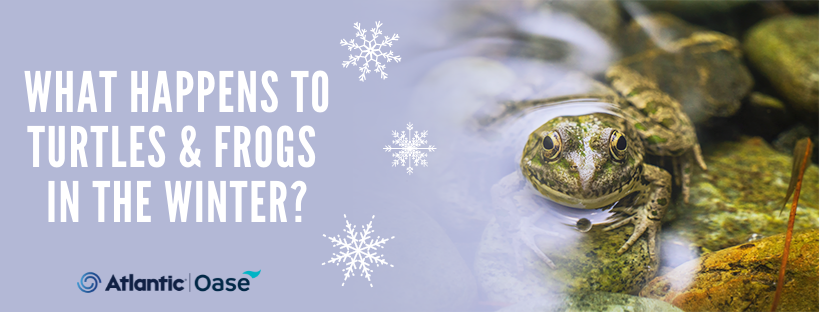Today was a reminder of just how brutal Winter can be – the car said it was a balmy 1° this morning on my way into work. Add in the wind chill and my freezer at home would feel positively comfy in comparison. When temperatures drop this low, some may wonder what happens to fish, turtles and frogs in the winter?
The cold is bad enough for us, and we have the equipment and technology to keep ourselves from freezing. Other warm blooded animals cope with the lack of warmth and food by hibernating. A bear will store up enough calories in fat to stoke her inner fire for months, find suitable shelter then go into suspended animation, lowering her temperature and metabolic functions to the very minimum needed to stay alive. She will ‘sleep’ thus until she runs out of stored fuel. She’s bet the farm that it will be warmer by then.
Cold blooded critters don’t generate inner heat. Their core is going to be the same as the temperature outside. So what happens to the various crawling, hopping and swimming critters in your pond when temps drop below freezing? They have to deal with freezing temperatures very differently than us warmbloods.

Fully aquatic animals and fish can hibernate in much the same way as warmbloods if the water is deep enough that it doesn’t freeze solid around them and there is sufficient oxygen. They take advantage of water’s unique properties. First, water can hold a lot more oxygen the colder it gets, so they can simply absorb it through gills and skin without physically moving to breathe. Then, the water at the bottom of the pond is always warmer than the ice on top, because unlike every other compound on the planet, frozen water is less dense than liquid water. Ice floats, right? Water is actually at its densest, and therefore heaviest, at a balmy 39 degrees Fahrenheit. That’s cold enough to slow the metabolism of fish, frogs and aquatic turtles way down, decreasing oxygen demand, but warm enough for them to simply hang out under the ice.
I watch my Koi just float, mostly motionless, through the icy window covering my pond. Turtles need so little oxygen they can sleep burrowed in the muck. Native Leopard Frogs need their skin exposed to absorb oxygen; they just sit on the bottom staring, waiting for Spring.
But how do terrestrial cold bloods deal with cold winters? They can’t take advantage of those ‘warm’ bottom waters insulated under ice and snow, they’d drown. They can’t hibernate because they don’t produce any inner heat to keep from freezing. These guys have to ‘brumate’. Their metabolism drops to near zero, they don’t breathe, their hearts may even stop beating and they partially freeze – then revive themselves in the Spring.
The challenge they face is to keep ice from forming inside the cells of their organs when temps drop. Ice crystals are sharp, and water expands when freezing, which would damage or destroy cell structures and burst cell membranes, killing the animal. Frogs, turtles and a number of other animals can partially freeze without damage the same way you winterize an RV – by filling the most critical structures with antifreeze.

As temps drop, they dump excess water inside their cells, expelling it into the spaces between the cells. Then they flood the cells with glucose, creating a concentrated sugar solution that resists freezing well below 32 degrees F. At the same time, special proteins bond to ice crystals in the water around the cells, blocking the individual crystals from attaching to each other. The water around the cell can freeze but the ice crystals stay in suspension instead of clumping together, keeping the ice from solidifying and harming the animal.

In this way, frogs can literally be 70% frozen, cocooned in mud all winter, not breathing, heart stopped, looking dead to the world. When Spring arrives they defrost, their lungs and hearts resume activity and they pop out of the mud unharmed. In fact, the sight of frogs and toads emerging from the ground as it thawed gave rise to the ancient notion that they were literally made of mud, a myth that wasn’t dispelled until the 18th century.
So, don’t worry about that frogsicle you thought croaked – chances are he will rise to croak again.

DEMI FORTUNA
Demi has been in water garden construction since 1986. As Atlantic’s Director of Product Information, if he’s not building water features, he’s writing or talking about them. If you have a design or construction question, he’s the one to ask.


